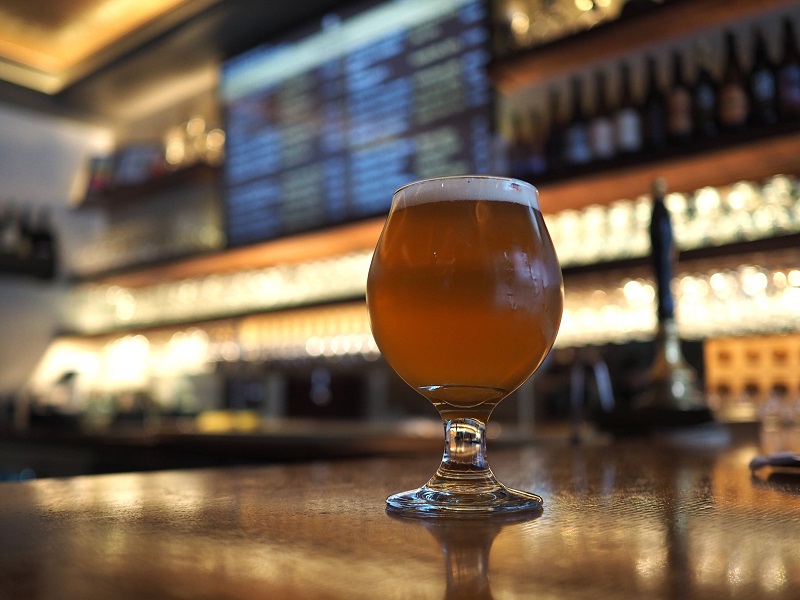Who Is This Brett and Why Is His Name on All These IPAs?

Tahoe Mountain Brewing Co.’s Party Boy Brett IPA. (Photo by Jon Page)
In the ever-expanding universe of beers labeled IPA is a newcomer that confuses just about everyone—the Brett IPA. Casual drinkers will wonder who or what Brett is and, tasting the beer, shrug and smile. Nerdier beer fans will recognize the name as a shortened nickname for Brettanomyces, a wild yeast strain. But that’s confusing, too; haven’t we all learned that Brett beers are barrel-aged, funky and dry? But Brett IPAs taste of none of those things; in fact, they usually bubble and fizz with amazing tropical fruit flavors, like regular IPAs in hyper drive.
So what’s going on? Let’s unpack this new IPA variant and find out why they’re so tasty.
Fermented With Brettanomyces
It’s true that the Brett stands for Brettanomyces, but it’s also misleading. In most beers, regular ale yeast (Saccharomyces) does the initial fermentation. In spontaneously-fermented beers, the Brett is present, but only rouses itself to action after the wild Saccharomyces have done an initial ferment. In other styles, brewers add Brett after primary fermentation and let the beer sit for months or years. Saccharomyces is quick and agile, but it leaves certain complex sugars behind. Wild Brett strains are more voracious, and they can come along and gobble those leftover sugars and continue to slowly ferment a beer. Along the way, they produce odd, funky flavors and aromas (barnyard, and horse-blanket are a couple of classic adjectives), and leave a beer very dry and austere.
That’s not what’s going on in a Brett IPA. Instead, brewers pitch Brett in place of Saccharomyces for primary fermentation. When used this way, it behaves more like regular ale yeast and will ferment a beer out in about the same amount of time. But, being a wild yeast, it produces vivid flavor and aroma compounds, notably esters, which taste like fruit. Some Brett strains produce esters that are especially tropical—much like American hops. Indeed, brewers started making these beers because the fermentation flavors harmonized perfectly with the tropical, fruity American hop varieties. They’re a marriage made in beer heaven.
How’s It Work?
Last fall, I was passing through New York and stopped in for a pint at the Blind Tiger. I was fortunate to have arrived at lunchtime, because I got the last precious drops of a keg of Brett IPA from Other Half Brewing. I wanted to learn how the brewery made the beer, so I gave co-owner and brewer Sam Richardson a call. I was curious how brewers get the tropical esters in these beers—and how they avoid getting austere, dry, barnyard-y wild ales.

Sam Richardson of Other Half Brewing. (Photo by Matt Coats)
There are two key elements to making these beers work—temperature and cell counts. “Usually we pitch it in the low to mid 70s and let it free ride,” Richardson said. Yeast cells produce energy when they’re dividing, multiplying, and doing their thing, and left alone a wort will gain 20 degrees or more. As yeast cells warm, they produce more of those compounds breweries are looking for. Richardson lets his fermenting wort rise up into the 80s—high for regular yeast, but good for the Brett. (If they get too warm, though, yeast cells get stressed and start to produce objectionable flavors.)
The second thing is pitching enough yeast. “It’s really about having proper cell counts for the Brett [to] ferment properly,” Richardson said. “The more you stress Brett, the more it tastes funky and off; you want the beer to taste fruity and have that drying Brett character, but I don’t want a lot of funk on it.” Sometimes brewers under-pitch regular yeast strains specifically because they want to stress the yeast so that it produces more character—Belgians commonly do this. But Brett is such a florid yeast strain that it doesn’t need to be strong-armed. Those funky barnyard flavors aren’t welcome in a hoppy IPA—brewers are just looking for the esters.
Interacting With Hops
There are other variables as well, but they make intuitive sense. Different strains of Brettanomyces will produce different flavors. Brewers select the strains they like, and then make hop selections to harmonize with the esters they create. Predictably, they go for fruity, tropical hops rather than piney or dank ones. “I prefer to use hops that come across as fruity as well, juicier and fruitier is better,” Richardson said, adding that he focuses on the flavors and aromas of hops rather than the steely bite of IBUs. “I feel too much bitterness in a beer like that, it just clashes.”
There’s a mysterious biochemical dance that happens when the compounds in hops interact with fermenting yeast, and it means the hops express themselves differently. “If you make a Brett beer with Mosaic, the Mosaic is going to present differently—even if you use the same grain bill and everything—than with Chico [a common neutral strain]. The ester production is going to affect how you perceive the hop character.” This is a feature more than a bug, though; it gives brewers a wider palette of flavors to work with.
Finally, a focus on all that flavor and aroma is important because these beers do dry out more than IPAs made with regular yeasts, which adds its own stiffness. “The Brett strain adds—I don’t know if I’d call it astringency—but even if the beer doesn’t get really [attenuated], it still has a dry quality to it,” Richardson said.
But, I wondered, what about that yeast—wouldn’t it still munch away once the beer was brewed and in the keg—and isn’t that a complication? Indeed. “As with any IPA, the hops drop out with age,” Richardson said. Any IPA is a race against time; in this case it’s a race against time for the hops and also [the yeast].” And of course, because the yeast is still active, the flavor profile changes. “It will continue to produce different compounds and the flavors will change. It’ll will become a different beer.” Richardson says he has to emphasize this point with his accounts; it’s best, he tells them, if they don’t sit on kegs of his Brett IPA.
If you happen to know all this, the name can tell you a lot. But I wonder if it’s not more trouble than it’s worth. Brett IPAs are a process variation on American IPAs, but they don’t taste particularly unusual. I mean, good versions taste fantastic, but the flavors are familiar: a heady aroma that might be redolent of mango, passion fruit, apricot, or tangerine, and lively, zingy fruit flavors layered throughout the palate. If you know to look for the telltale dryness, which stiffens all those fruity flavors (and can track as “sweet” in the mind), you might recognize the presence of the Brett. But otherwise, they just seem like classic American IPAs.
But then again, now you do know all this. So keep your eyes peeled and if you see “Brett IPA” on a tap list somewhere, grab it quick.
Jeff Alworth is the author of the book, The Beer Bible (Workman, 2015). Follow him on Twitter or find him at his blog, Beervana.

Interesting new concept! Do the brewers need to use exclusive fermenters, brite tanks, hoses, kegs, etc to avoid cross contamination with other ale batches?
Absolutely Logan! Many breweries who have both wild and “clean” (non wild yeast) programs have completely separate facilities. Here at The Bruery and Bruery Terreux, our facilities are 3 miles apart with dedicated staff and equipment. But it wasn’t always this way.
Check out our blogs for some more information about our two brands, via thebruery.com/blog and brueryterreux.com/blog.
Cheers!
I suspect every brewery handles this differently, but yes; Brett in the brewery is always dangerous.
Had a beer last night with Brett in it and it was really weird and funky. I was wondering if perhaps this beer was old and the Brett was over fermented??? I don’t know, it was a very odd smell and taste. Hard to describe. Cat urine comes to my mind. Just way weird. The beer wasn’t horrible, I didn’t have to toss it. Matter of fact, I kept drinking it because I was trying so hard to figure out what in heck I was drinking!
Cat urine was probably from the hops they used. Fresh Simcoe and Mosaic can give off that smell.
Weird and funky, horse blanket, musty, pretty much describes Brett.